Translate this page into:
Global stability and modeling with a non-singular kernel for fractional order heroin epidemic model: Insights from different population studies
⁎Corresponding author. talatn@unisa.ac.za (Talat Nazir)
-
Received: ,
Accepted: ,
This article was originally published by Elsevier and was migrated to Scientific Scholar after the change of Publisher.
Abstract
There has been a worldwide epidemic of heroin that has affected people, families, societies, and cultures across the world. Now, the heroin epidemic has transitioned from heroin abuse to the overuse of synthetic narcotics, which are widely accessible and inexpensively produced. In this work, a novel mathematical approach is applied to investigate the dynamics of the heroin epidemic model and its harmful effect on society with different population data. A heroin model has been constructed with the importance of a non-singular kernel in the sense of a generalized Mittag-Leffler kernel. The well-posedness of the proposed model is proven via fixed-point theory. To examine the heroin model, two equilibrium states have been determined. These equilibrium states are proven to be locally and globally asymptotically stable. To analyze the behavior of heroin, a basic reproduction number and sensitivity analysis are used to determine the impact of different parameters mathematically as well as through simulations. To find the approximate solution, we implement the Toufik–Atangana numerical method at different fractional order values. The sensitivity of the heroin model is carried out, and 3-D graphs show the significance of the parameter involved in the model. Finally, the numerical outcomes are presented with different values of fractional parameters.
Keywords
Heroin epidemic model
Atangana–Baleanu fractional derivative
Sensitivity analysis
Stability
Numerical solution
Data availability
Our manuscript has no associated data.
1 Introduction
The escalating intake of drugs and other dangerous substances is a severe concern. Heroin addiction affects not just the level of life for the vast majority of people but also, to a greater extent, the overall picture of world peace and economic prosperity (Xu, 2023; Glicksberg et al., 2023). Based on data from the United Nations (U.N.) World Drug Report, 35 million people have severe problems related to drug misuse, and only around a seventh are receiving a cure (Fabien, 2018). In addition, it was disclosed that drug addiction occurred globally in 2017, with 3 million cases of HIV and 6.2 million cases of severe hepatitis B viral infections. Metric records indicate that the detrimental physiological effects of drug use are more widespread and substantial than previously thought and that controlling the prevalence of harmful drugs is essential (Saha and Samanta, 2019; Tolomeo et al., 2021).
An indispensable mechanism for comprehending and treating drug addiction challenges is mathematically modeled (Raza et al., 2023). It has come to light that models are beneficial tools for forecasting drug users’ behavior patterns and offering practical recommendations for therapeutic approaches (Chou and D’Orsogna, 2022; Raza et al., 2022b). Narcotic drug misuse, including heroin consumption, is already a major societal issue. Wangari and Stone (2017) have investigated the spread of heroin addiction in society with the saturated treatment function. Zhang and Xing (2020) have formulated a reaction–diffusion heroin disease model with stability analysis. The authors in Huang and Liu (2013) proposed a distributed delay model of heroin and examined the dynamics in the population. In Liu and Wang (2016), the authors have modeled the heroin model with the saturating rate of non-linear occurrence and provided conditions for the global disease dynamics. Khan et al. (2021) have discussed preferable control factors for heroin spread with sensitivity.
A noteworthy advancement has recently been made in fractional calculus, using new derivative and integral operators with kernels (Butt et al., 2023a,c; Zafar et al., 2021). The creatively suggested element takes advantage of a modified version of the Mittag-Leffler function (MLF), this structure encompasses the keystone and its properties, which play a vital role in developing innovative methods to attain various fascinating characteristics, like the expanding variations and mean square deformation interphase that are found in significant scenarios. The authors in Zafar et al. (2021) developed a heroin model using a fractional operator. Weera et al. (2023) have considered a fractional heroin model for the numerical solutions. The groundbreaking fractional derivative operator, developed by Atangana and Baleanu in 2016, has widespread use in several scientific and technological fields. It has been demonstrated that utilizing the AB-fractional operator in simulation produces a disordered framework. for a brief time (Syam and Al-Refai, 2019; Bas and Ozarslan, 2018; Gomez-Aguilar et al., 2016; Owolabi and Atangana, 2019). The AB-fractional derivative is an excellent mathematical method for modeling progressively complex critical difficulties in the setting of Caputo since it has now been found that the MLF is a more significant and effective filtering procedure than the exponential and power laws.
In this work, we develop an epidemic model of heroin comprising addiction and enduring immunity, then explore the worldwide patterns triggered by the previous arguments. We used the new ABC-fractional method and Toufik–Atangana’s approach (Mekkaoui and Atangana, 2017) to create a fractional representation and evaluate numerical results. To the researchers knowledge, a few studies have used the ABC-fractional operator to analyze the heroin epidemic scenario. Additionally, the researchers claim that there is an absence of appropriate research that examines robust management of computational structures from the standpoint of ABC-fractional forms.
The paper’s structure is as follows: In Section 2, we delve into the dynamics of heroin, providing detailed explanations and introducing fundamental concepts in fractional calculus. Moving on to Section 3, we demonstrate the model’s existence and uniqueness using mathematical approaches. Section 4 is dedicated to analyzing the model’s stability analytically. Section 5 covers the numerical method and its corresponding results. Finally, Section 6 offers insights into the research’s overall conclusions.
2 Formulation and configuration of heroin model
This section outlines the creation of the heroin disease epidemic model (Raza et al., 2022a), and three subgroups comprise the whole population. represents susceptible persons, shows drug users, and displays non-drug users, which are the state variables in the model, respectively. This model considers the following assumptions:
-
The total population is the sum of all the subclasses and its size is assumed to be fixed in the whole period.
-
All the biological parameters must be nonnegative or positive.
-
Homogeneous mixing is considered.
-
All of the individuals are supposed to be identically susceptible to drug habit.
Therefore, the heroin epidemic’s expansion is visualized in Fig. 1, and it is elucidated through the accompanying set of ODEs:
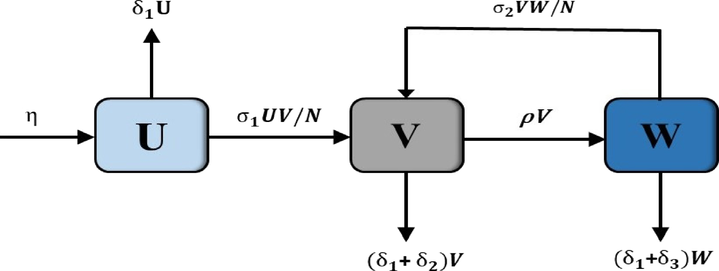
The heroin epidemic’s expansion within sub populations.
Due to the complex structure of the population, we equalize the system (1) by subsidizing the state variables:
as follows
The traditional derivative neglects memory effects that exist in numerous biological structures. Therefore, We employ the Atangana–Baleanu fractional derivative in place of the conventional integer-order derivative in order to enlarge framework (2) for the present study. This transformation will enable us to track memory effects and get further insights into the dynamics of the heroin epidemic. Before continuing, we revisit key aspects of Atangana–Baleanu and Caputo derivatives (Butt et al., 2023b; Abdeljawad and Baleanu, 2017; Rashid et al., 2022; Butt et al., 2022).
Parameter
Interpretation
New drug users
Probability rate of infection
Non-drug consumers have a high probability of becoming drug consumers.
Individuals who quit using drugs as a habit
Rate of drug-related deaths
Death rate for drug-related deaths following treatment
Drug users’ transition to becoming non-users
Consider
,
, be a mapping and then, the Atangana–Baleanu fractional derivative in Caputo sense is expressed (Butt et al., 2023b) as:
The AB-fractional integral of the function
is written by Butt et al. (2023b):
For
, then both the AB-fractional derivative and integral operator satisfies the Newton–Leibniz identity (Abdeljawad and Baleanu, 2017):
For two functions
,
, then the AB-fractional operator satisfies the subsequent variant (Abdeljawad and Baleanu, 2017; Rashid et al., 2022):
Therefore, the system (2) can be extended to a fractional framework of order
, with constant transmission rates. Thus, the Atangana–Baleanu fractional derivative defines our proposed model:
(Abdeljawad and Baleanu, 2017; Rashid et al., 2022) Suppose that and assume , . Then, we have , when .
It is noticed that by Lemma 3, if , and , for all , , then the function is increasing, and if , for all , then the function is decreasing for all .
Utilizing Lemma 3, we show the accumulation remains positively invariant, we have
On using the inverse Laplace transform, yields
3 Existence and uniqueness of heroin model
Model (8) provides a framework for analysis that incorporates the dynamics of the heroin epidemic, and the ABC-fractional derivative system may be represented as
Below is a discussion of the alternatives for fractional-order systems, including their existence and uniqueness of solutions. We employ the renowned Banach fixed-point theorem (Banach, 1922) to establish the existence of a solution to problem (8). For an in-depth examination of some useful results of fixed point and compressions, you can turn to Ref. Panda (2020), Şahin et al. (2023), Şahin and Alagöz (2023), Aggarwal et al. (2023).
Theorem 1 Banach, 1922
Let be a complete metric space and mapping satisfies where is a constant. Then there exists a unique such that . Moreover, for any , the iterative sequence converges to .
We shall now show the existence and uniqueness of the solution by following the procedures listed below. The formulation (8) is handled using the AB-fractional integral:
The contraction and the Lipschitz assumption provide the cornerstones of our subsequent theorem.
If the kernels are
,
in (8), then there exists
,
, such that
We shall commence from the initial category denoted as
. In this context, let
and
represent two mappings. It is essential to consider the following factors:
Now for
,
, we present the iterative relationship of (15) that follows:
To determine the difference between the subsequent components, utilize the following equations:
The theorem is now described in detail as follows.
The suggested heroin fractional model (8) has exact solutions if the following suppositions exist: that is, we can workout
such that
Utilizing Eqs. (25)–(27), we have
The existence of fractional model (8) is guaranteed by Theorems 2 and 3 with the implementation of Banach fixed point theorem. Our following result will demonstrate the singularity of the solutions.
The suggested heroin fractional model (8) has a unique solution, if
Assume that
,
, and
are other solutions to (8). Then
4 Qualitative perspectives of the heroin model
4.1 Equilibrium points and basic reproduction number
The proposed fractional heroin epidemic model (8) has two equilibrium points in the feasible region of the model (9). To determine the equilibrium states of the suggested system, we put
which gives that
Basic reproduction number is a principle parameter of infectious disease models and usually represented by . This is referred to as the estimated count of secondary infections generated by one infected person within a population entirely susceptible to the infection. For the proposed heroin fractional epidemic model, is developed utilizing the upcoming generation matrix strategy (Ahmad et al., 2021; Riaz et al., 2024; Ain et al., 2024).
The suggested system can be written as
4.2 Stability analysis
This section discusses the local and global behavior of the considered model (8) at the heroin-free and heroin persistence equilibrium states that by imposing constraints on the .
4.2.1 Stability of heroin free equilibrium point
Theorem 5 Butt et al., 2023a
Heroin free equilibrium point of system (8) is locally asymptotically stable if and unstable when .
The Jacobian matrix
for proposed fractional model (8) at heroin free state
is computed as:
Theorem 6 Butt et al., 2023a
Heroin free equilibrium point of system (8) is globally asymptotically stable (GAS) if and unstable when .
To examine the global behavior of heroin free equilibrium point, we choose a Lyapunov function as:
4.2.2 Stability of heroin persistence equilibrium point
Theorem 7 Butt et al., 2023a
Heroin persistence equilibrium point of system (8) is locally asymptotically stable if and unstable when .
The Jacobian matrix
for the considered fractional model (8) at heroin persistence
is computed as:
Theorem 8 Butt et al., 2023a
Heroin persistence equilibrium point of system (8) is globally asymptotically stable if and unstable when .
Let us consider a Lyapunov function candidate as:
5 Numerical analysis
This section is devoted for the numerical results and simulations of heroin epidemic model using a well known approach constructed by Toufik and Atangana (Mekkaoui and Atangana, 2017). We now implement this scheme to each equation of the system (8) to get the numerical solutions of the proposed system, we obtain the following results:

Dynamics of the populations of heroin model at heroin persistence state at different values of
.
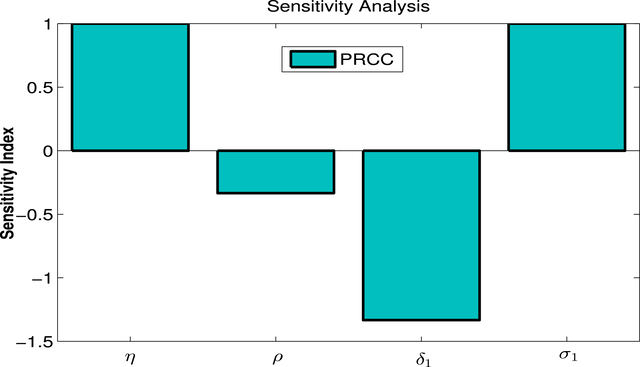
PRCC statistics regarding the significance of factors associated with
.
5.1 Sensitivity analysis
Making decisions about effectively managing a disease necessitates careful consideration of the sensitivity analysis concept. The sensitivity analysis enables us to examine how variables fluctuate when the parameters in are altered. It highlights the model’s most sensitive and impactful parameters and their effects on (Butt et al., 2023a,b).
(Butt et al., 2023b) The normalized forward sensitivity index (
) of the basic reproduction number
that depends on a parameter
is provided below as:
To examine the sensitivity of , we compute its derivatives as follows: The normalized sensitivity indices of the involved parameters are obtained as:
Table 2 and Fig. 3 depict the favorable influence of and on the threshold parameter . This indicates that higher values of these parameters result in an increase in . The sensitivity indices obtained clearly show 10% rise in the new drug users, and infection rate occurs to raise the value of by 10%, 10%, correspondingly, and can ultimately leading to a disease outbreak. Across the other perspective, is negatively impacted by and as shown by Fig. 4 (see Table 3).
Sensitivity index
Value
−1.3333
−0.3333
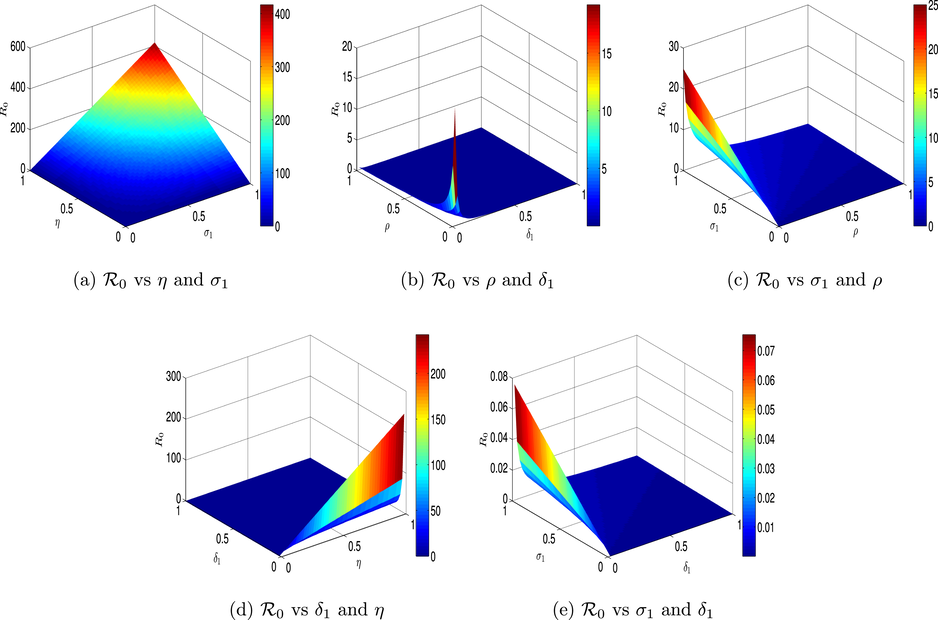
The behaviors of
under different biological parameters.
Initial condition
Value
Source
0.50
Raza et al. (2022a)
0.30
Raza et al. (2022a)
0.20
Raza et al. (2022a)
Parameter
Value
Source
0.04
Raza et al. (2022a)
0.02 for
(0.20 for
)
Raza et al. (2022a)
0.03
Raza et al. (2022a)
0.04
Raza et al. (2022a)
0.02
Raza et al. (2022a)
5.2 Numerical results and discussion
This subsection examines the effect of the fractional parameter on the heroin epidemic disease in the model. A graphical outcome of the model application (8) that depicts the impacts of fractional order on the population in every section. We have illustrated the heroin dynamics of a model for and , respectively. For the heroin-free equilibrium, an elevation in the value of from 0.80 corresponds to boost in the count of susceptible cases. However, the populations of drug users and non-drug users decline undeviatingly by increasing the value of from 0.8. In contrast, the susceptible decreases with the rise of fractional parameters in heroin persistence point and the behavior of drug users and non-drug users is observed oppositely, as illustrated by Fig. 2. At the end, when contemplating the case where , we arrived at the results of Raza et al. (2022a), where a different numerical approach was used. The behavior of the individuals is illustrated in Fig. 5 at different values of by fixing the value of the fractional parameter. These results show a distinct trend, the proportion of susceptible people declines as the infection probability rate rises. The reason for this is that a greater number of people who were previously susceptible to infection are now either recovering or current drug users due to the increased likelihood of infection. On the other hand, as the probability of infection increases, so does the population of drug users. As there is a direct association between the probability of infection and the number of new drug users, this increase happens because a greater infection rate makes more susceptible people more likely to start using drugs. On the other side, the findings indicate a rise in non-drug users, which may be people who have abstained from drug use in the past but have recovered or those who have rejected using drugs despite the risk of infection. The fact that this group is expanding suggests that, despite greater dangers, some members of the population at risk can recover or avoid infection.
The behavior of the individuals is illustrated in Fig. 6 at different values of
by fixing the value of the fractional parameter. According to the analysis, fewer people are susceptible to heroin use when the chance rate, that is, the rate at which people are exposed to or attracted by the drug—increases. This occurs because there is a greater probability that those at risk will become drug users when the chance rate is higher. With a rise in the chance rate, there is a consistent rise in the population of drug users. This pattern shows that increasing exposure or temptation rates leads to more people shifting from being vulnerable to actually using heroin. As the chance rate rises, the proportion of non-drug users falls. This group comprises people who have either never used heroin or who have overcome their addiction. This group may decline as a result of a higher chance rate, making it more difficult for people to prevent or rehabilitate from habit.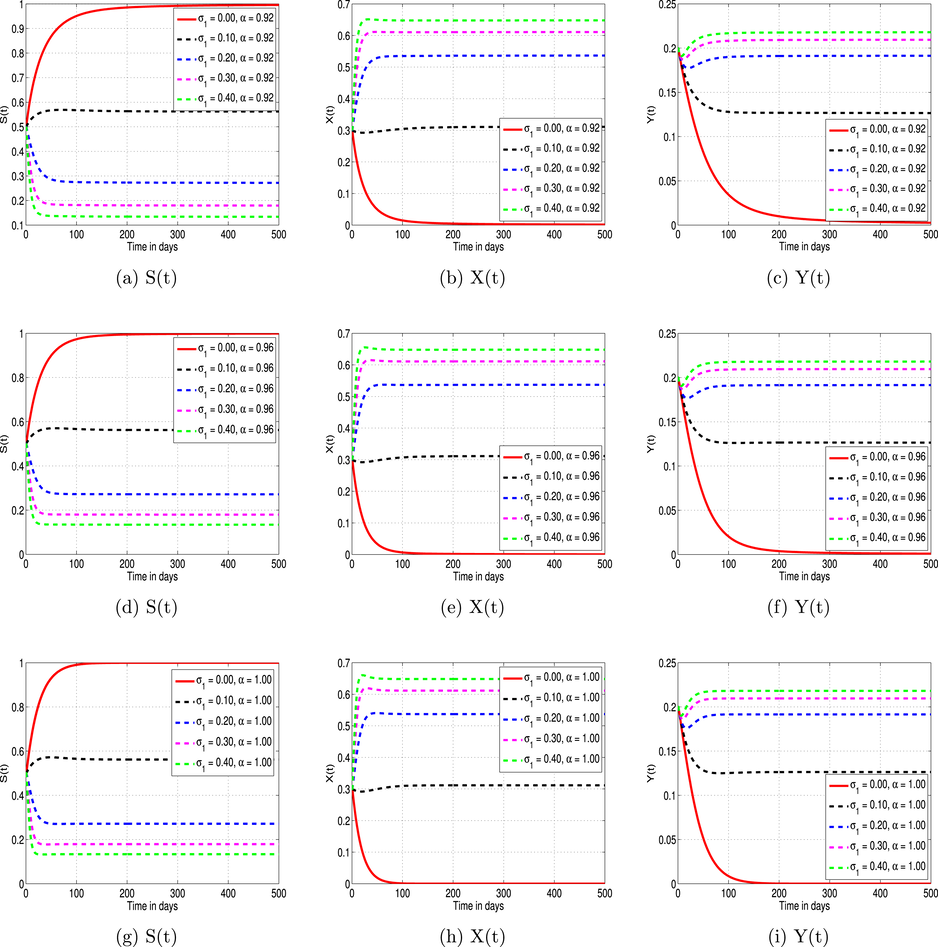
Effect of
on the behavior of heroin model populations for
and
.
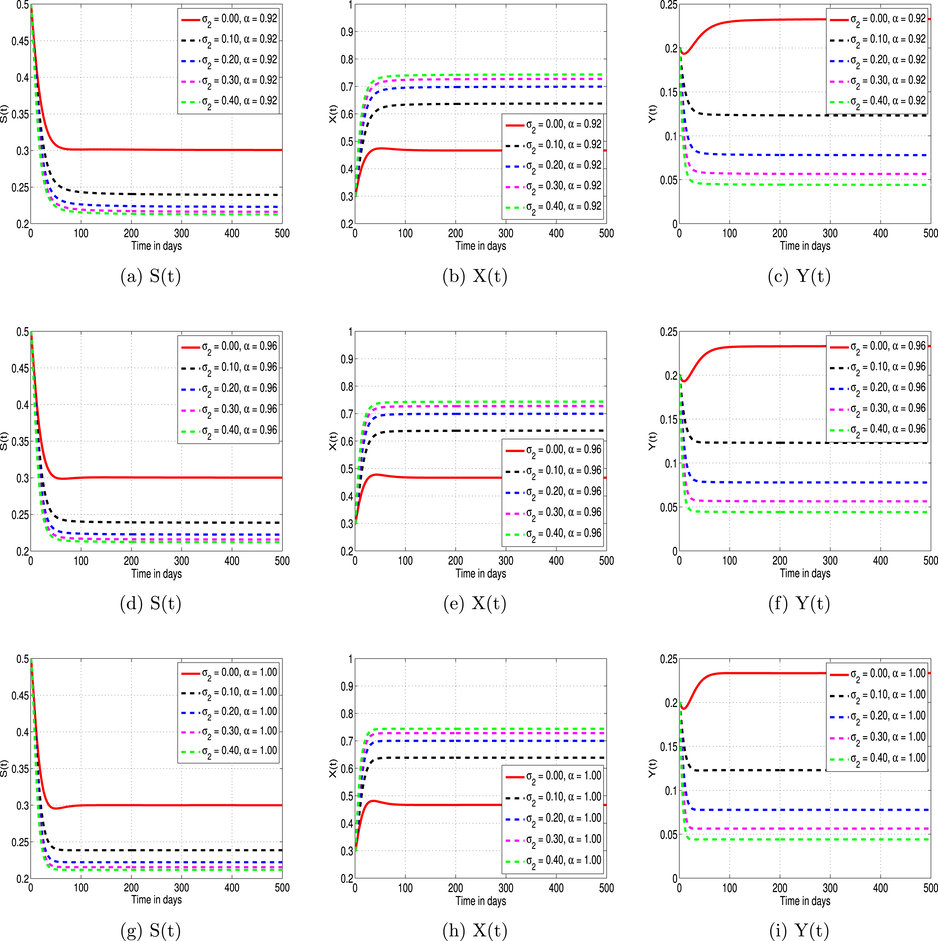
Effect of
on the behavior of heroin model populations for
and 1.00.
After examining, it can be stated that the mechanisms of heroin addiction are shaped by both the infection probability rate and the chance rate. A multimodal strategy that incorporates lowering risk factors, improving recovery guides, and putting in place powerful educational activities is necessary for successful management and safeguarding against heroin addiction. Public health measures can more successfully stop the rapid growth of heroin addiction and assist those who are impacted in a successful recovery by considering these factors.
6 Conclusion
In this manuscript, we have developed a novel fractional epidemic model of heroin population consequences by applying the Atangana–Baleanu fractional derivative. The fundamental reproduction number has been determined to investigate the dynamical behavior of the fractional model. The effects of heroin can be controlled by using a reproduction number. The primary properties such as positiveness, boundedness, existence, and uniqueness of the solution have been validated. It has been concluded that the equilibrium states are locally and globally asymptotically stable. In the end, we have applied a computational approach that assesses the dynamics of the proposed system. The results of the numerical technique show that the susceptible people increase with the increase in fractional order, and the other two subpopulations show opposite behavior.
CRediT authorship contribution statement
Miguel Vivas-Cortez: Data curation, Funding acquisition, Methodology. Abu Bakar: Formal analysis, Software, Validation. M.S. Alqarni: Conceptualization, Resource Management, Methodology. Nauman Raza: Investigation,Supervision, Validation. Talat Nazir: Supervision, Project administration, Data curation. Muhammad Farman: Methodology, Validation.
Acknowledgments
The authors extend their appreciation to the Deanship of Research and Graduate Studies at King Khalid University, Saudi Arabia for funding this work through Large Research Project under grant number RGP2/113/45. The authors thank the anonymous referees for their valuable constructive comments and suggestions, which improved the quality of this paper in the present form.
Declaration of competing interest
The authors declare that there is no conflict of interest regarding the submission of this paper.
References
- Integration by parts and its applications of a new nonlocal fractional derivative with Mittag-Leffler nonsingular kernel. J. Nonlinear Sci.. 2017;10(3):1098-1107.
- [CrossRef] [Google Scholar]
- On common fixed points of non-Lipschitzian semigroups in a hyperbolic metric space endowed with a graph. J. Anal. 2023:2023.
- [CrossRef] [Google Scholar]
- Mathematical analysis for the effect of voluntary vaccination on the propagation of Corona virus pandemic. Results Phys.. 2021;31:104917
- [CrossRef] [Google Scholar]
- A stochastic approach for co-evolution process of virus and human immune system. Sci. Rep.. 2024;14(1):10337.
- [Google Scholar]
- Sur les opérations dans les ensembles abstraits et leur application aux équations intégrales. Fund. Math.. 1922;3:133-181.
- [Google Scholar]
- Real world applications of fractional models by Atangana - Aleanu fractional derivative. Chaos Solit. Fractals. 2018;116(2018):121-125.
- [CrossRef] [Google Scholar]
- Numerical analysis of Atangana-Baleanu fractional model to understand the propagation of a novel Corona virus pandemic. Alex. Eng. J.. 2022;61(9):7007-7027.
- [CrossRef] [Google Scholar]
- Dynamical analysis of a nonlinear fractional cervical cancer epidemic model with the nonstandard finite difference method. Ain Shams Eng. J. 2023102479
- [CrossRef] [Google Scholar]
- Investigating the fractional dynamics and sensitivity of an epidemic model with nonlinear convex rate. Results Phys.. 2023;54:107089
- [CrossRef] [Google Scholar]
- Optimally analyzed fractional coronavirus model with Atangana-Baleanu derivative. Results Phys.. 2023;53:106929
- [CrossRef] [Google Scholar]
- A mathematical model of reward-mediated learning in drug addiction. Chaos. 2022;32(2):021102
- [CrossRef] [Google Scholar]
- United nations office on drugs and crime: World drug report 2017. SIRIUS-Zeitschrift für Strategische Analysen. 2018;2(1):85-86.
- [Google Scholar]
- Heroin and fentanyl in dallas county: A 5-year retrospective review of toxicological, seized drug, and demographical data. J. Forensic Sci.. 2023;68(1):222-232.
- [CrossRef] [Google Scholar]
- Atangana-Baleanu fractional derivative applied to electromagnetic waves in dielectric media. J. Electromagn. Waves Appl.. 2016;30(15):1937-1952.
- [CrossRef] [Google Scholar]
- A note on global stability for a heroin epidemic model with distributed delay. Appl. Math. Lett.. 2013;26(7):687-691.
- [CrossRef] [Google Scholar]
- Optimal control strategies for a heroin epidemic model with age-dependent susceptibility and recovery-age. AIMS Math.. 2021;6(2):1377-1394.
- [CrossRef] [Google Scholar]
- The Stability of Dynamical Systems, Regional Conference Series in Applied Mathematics. Philadelphia, Pa, USA: SIAM; 1976.
- [CrossRef]
- Epidemic dynamics on a delayed multi-group heroin epidemic model with nonlinear incidence rate. J. Nonlinear Sci. Appl.. 2016;9(5):2149-2160.
- [CrossRef] [Google Scholar]
- New numerical approximation of fractional derivative with non-local and non-singular kernel: Application to chaotic models. Eur. Phys. J. Plus. 2017;132(444):1-16.
- [CrossRef] [Google Scholar]
- On the formulation of Adams–Bashforth scheme with Atangana-Baleanu-Caputo fractional derivative to model chaotic problems. Chaos. 2019;29:023111
- [CrossRef] [Google Scholar]
- Applying fixed point methods and fractional operators in the modelling of novel Coronavirus 2019-nCoV/SARS-CoV-2. Results Phys.. 2020;19:103433
- [CrossRef] [Google Scholar]
- New numerical dynamics of the heroin epidemic model using a fractional derivative with Mittag-Leffler kernel and consequences for control mechanisms. Results Phys.. 2022;35:105304
- [Google Scholar]
- Dynamical and nonstandard computational analysis of heroin epidemic model. Results Phys.. 2022;34:105245
- [CrossRef] [Google Scholar]
- Numerical simulations of the fractional-order SIQ mathematical model of Corona virus disease using the nonstandard finite difference scheme. Malays. J. Math. Sci.. 2022;16(3)
- [CrossRef] [Google Scholar]
- A numerical efficient splitting method for the solution of HIV time periodic reaction–diffusion model having spatial heterogeneity. Phys. A. 2023;609:128385
- [CrossRef] [Google Scholar]
- Fractional dynamics and sensitivity analysis of measles epidemic model through vaccination. Arab J. Basic Appl. Sci.. 2024;31(1):265-281.
- [Google Scholar]
- Dynamics of an epidemic model with impact of toxins. Phys. A. 2019;527:121152
- [CrossRef] [Google Scholar]
- On the approximation of fixed points for the class of mappings satisfying (CSC)-condition in Hadamard spaces. Carpathian Math. Publ.. 2023;15(2):495-506.
- [CrossRef] [Google Scholar]
- Some fixed-point results for the -iteration process in hyperbolic metric spaces. Symmetry. 2023;15(7):1360.
- [CrossRef] [Google Scholar]
- Fractional differential equations with Atangana-Baleanu fractional derivative: Analysis and applications. Chaos Solit. Fractals X. 2019;2:100013
- [CrossRef] [Google Scholar]
- Chronic heroin use disorder and the brain: Current evidence and future implications. Progr. Neuro-Psychopharmacol. Biol. Psychiat.. 2021;111:110148
- [CrossRef] [Google Scholar]
- Analysis of a heroin epidemic model with saturated treatment function. J. Appl. Math. (2017)
- [CrossRef] [Google Scholar]
- A neural study of the fractional heroin epidemic model. Comput. Mater. Contin.. 2023;74(2):2.
- [CrossRef] [Google Scholar]
- Dynamical analysis of a heroin - cocaine epidemic model with nonlinear incidence and spatial heterogeneity. J. Biol. Dyn.. 2023;17(1):2189026
- [CrossRef] [Google Scholar]
- Fractional order heroin epidemic dynamics. Alex. Eng. J.. 2021;60(6):5157-5165.
- [CrossRef] [Google Scholar]
- Stability analysis of a reaction–diffusion heroin epidemic model. Complexity 2020:1-16.
- [CrossRef] [Google Scholar]







